Contents
| |||||
| Decades: | |||||
|---|---|---|---|---|---|
| See also: | Other events of 1702 List of years in Spain | ||||

Events in the year 1702 in Spain .
| |||||
| Decades: | |||||
|---|---|---|---|---|---|
| See also: | Other events of 1702 List of years in Spain | ||||

Events in the year 1702 in Spain .

1620 (MDCXX) was a leap year starting on Wednesday of the Gregorian calendar and a leap year starting on Saturday of the Julian calendar, the 1620th year of the Common Era (CE) and Anno Domini (AD) designations, the 620th year of the 2nd millennium, the 20th year of the 17th century, and the 1st year of the 1620s decade. As of the start of 1620, the Gregorian calendar was 10 days ahead of the Julian calendar, which remained in localized use until 1923.

1781 (MDCCLXXXI) was a common year starting on Monday of the Gregorian calendar and a common year starting on Friday of the Julian calendar, the 1781st year of the Common Era (CE) and Anno Domini (AD) designations, the 781st year of the 2nd millennium, the 81st year of the 18th century, and the 2nd year of the 1780s decade. As of the start of 1781, the Gregorian calendar was 11 days ahead of the Julian calendar, which remained in localized use until 1923.

1702 (MDCCII) was a common year starting on Sunday of the Gregorian calendar and a common year starting on Thursday of the Julian calendar, the 1702nd year of the Common Era (CE) and Anno Domini (AD) designations, the 702nd year of the 2nd millennium, the 2nd year of the 18th century, and the 3rd year of the 1700s decade. As of the start of 1702, the Gregorian calendar was 11 days ahead of the Julian calendar, which remained in localized use until 1923.
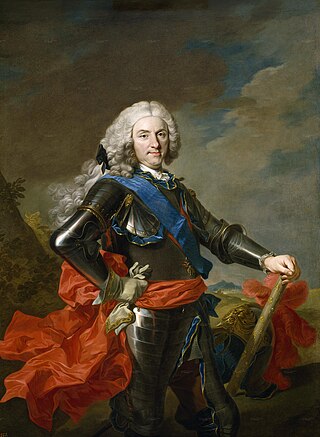
Philip V was King of Spain from 1 November 1700 to 14 January 1724 and again from 6 September 1724 to his death in 1746. His total reign is the longest in the history of the Spanish monarchy, surpassing Philip IV. Although his ascent to the throne precipitated the War of the Spanish Succession, Philip V instigated many important reforms in Spain, most especially the centralization of power of the monarchy and the suppression of regional privileges, via the Nueva Planta decrees, and restructuring of the administration of the Spanish Empire on the Iberian Peninsula and its overseas regions.

Vigo is a city and municipality in the province of Pontevedra, within the autonomous community of Galicia, Spain. Located in the northwest of the Iberian Peninsula, it sits on the southern shore of an inlet of the Atlantic Ocean, the Ria de Vigo, the southernmost of the Rías Baixas. It is the capital of the comarca of Vigo.
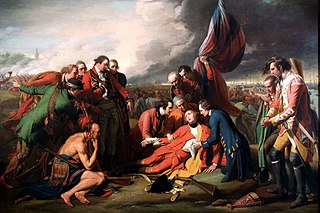
Events from the year 1702 in Canada.

Admiral of the Fleet Sir George Rooke was an English naval officer. As a junior officer he saw action at the Battle of Solebay and again at the Battle of Schooneveld during the Third Anglo-Dutch War. As a captain, he conveyed Prince William of Orange to England and took part in the Battle of Bantry Bay during the Williamite War in Ireland.

The War of the Quadruple Alliance was fought from 1717 to 1720 by Spain and the Habsburg Monarchy, with the latter being joined in 1718 by Great Britain, France, and Savoy, and in 1719 by the Dutch Republic. Caused by Spanish attempts to recover territories in Italy ceded in the 1713 Peace of Utrecht, most of the fighting took place in Sicily and Spain, with minor engagements in North America. Spain also promoted the Jacobite rising of 1719 in Scotland in an effort to divert British naval resources.
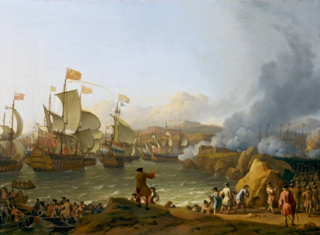
The Battle of Vigo Bay, also known as the Battle of Rande, was a naval engagement fought on 23 October 1702 during the opening years of the War of the Spanish Succession. The engagement followed an Anglo-Dutch attempt to capture the Spanish port of Cádiz in September in an effort to secure a naval base in the Iberian Peninsula. From this station the Allies had hoped to conduct operations in the western Mediterranean Sea, particularly against the French at Toulon.
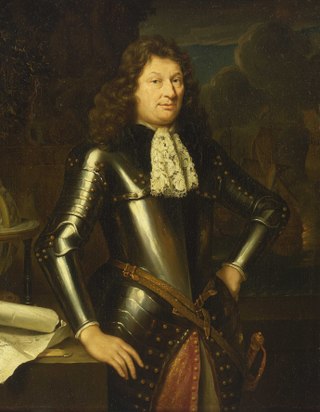
Philips van Almonde was a Dutch States Navy officer who served in his nation's maritime conflicts of the 17th and early 18th centuries.

Zenón de Somodevilla y Bengoechea, 1st Marquess of Ensenada, commonly known as the Marquess of Ensenada, was a Spanish statesman. He played a key role in crafting and enforcing the Great Gypsy Round-up, officially known as the General Imprisonment of the Gypsies, which was an attempt to exterminate the Roma living in Spain, leading to the death of 12,000 Romani People.

Admiral of the Fleet George Byng, 1st Viscount Torrington,, of Southill Park in Bedfordshire, was a Royal Navy officer and statesman. While still a lieutenant, he delivered a letter from various captains to Prince William of Orange, who had just landed at Torbay, assuring the Prince of the captains' support; the Prince gave Byng a response which ultimately led to the Royal Navy switching allegiance to the Prince and the Glorious Revolution of November 1688.

British America collectively refers to various European colonies in the Americas prior to the conclusion of the American Revolutionary War in 1783. The British monarchy of the Kingdom of England and Kingdom of Scotland—later named the Kingdom of Great Britain, of the British Isles and Western Europe—governed many colonies in the Americas beginning in 1585.
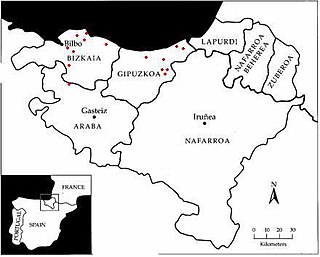
Bengoetxea, Bengoechea or Bengoetchea is a Basque surname which is common all throughout the Basque Country, especially in cities such as: Murelaga, Lizarza, Alkitza, Aizarna, Aulestia, Igeldo, Oiartzun, Aia, Olaberria, Lazkano, Berrobi (Tolosa) and Zizurkil in Gipuzkoa; Valley of Orozko, Mungia, Zeberio, Mundaka and Galdakao in Biscay; and in Arrieta and Baranbio (Amurrio) in Alava.
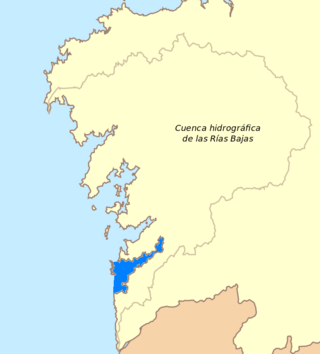
Vigo Ria and is an estuary in Galicia, Spain. It is the southernmost ria of the Rías Baixas. It is located in the south of the province of Pontevedra, and extends in a northeast direction over a distance of 35 kilometres (22 mi) from its mouth at Cape Silleiro to the deepest point in Arcade, with a maximum width of 7 km (4.3 mi) and the narrowest in the Strait of Rande, at 700 m (2,300 ft). Its western entrance is protected by the Cies Islands, which are part of the National Park of the Atlantic Islands which is within the islands of Toralla and San Simon. It borders to the north with the Morrazo Peninsula. In the extreme south lies the Bay of Baiona. Its easy access, depth and calm waters make the Vigo estuary an ideal retreat for sailing and water sports.
Francisco José de Ovando y Solís Rol de La Cerda, 1st Marquis of Brindisi was a Spanish soldier who served as Governor-General of the Philippines and governor of Chile.

Events in the year 1749 in Spain.
The Real Astillero de Esteiro was a royal shipyard in Ferrol in Spain. Orders for its construction were issued by Ferdinand VI of Spain on 9 April 1749, following the decision by the naval minister Zenón de Somodevilla, 1st Marqués de la Ensenada, to build new naval fortifications and installations in Ferrol and its surrounding area. Initial construction was managed by Cosme Álvarez, Comandante General of the Department. It was sited on the northwest slope of the monte Esteiro near Ferrol. It was initially planned to have four levels, but by the end this rose to twelve, proportional to the mountain's slope. Barracks, workshops and warehouses were also built.
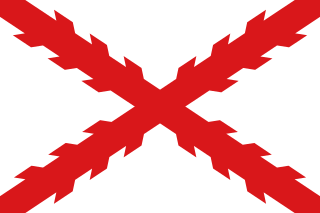
The Kingdom of Spain entered a new era with the death of Charles II, the last Spanish Habsburg monarch, who died childless in 1700. The War of the Spanish Succession was fought between proponents of a Bourbon prince, Philip of Anjou, and the Austrian Habsburg claimant, Archduke Charles. After the wars were ended with the Peace of Utrecht, Philip V's rule began in 1715, although he had to renounce his place in the succession of the French throne.
Cenon is a commune in Nouvelle-Aquitaine, France.